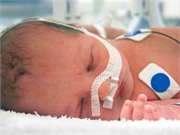Opioid-Addicted Babies Cost U.S. More Than $500 Million Annually
By Dennis ThompsonHealthDay Reporter

MONDAY, Dec. 16, 2019 (HealthDay News) -- Babies born addicted to opioids cost the U.S. health care system more than half a billion dollars a year, a new study finds.
The rate of infants born with neonatal abstinence syndrome (NAS) was 6.7 per 1,000 hospital births in 2016, four times the rate of 1.5 per 1,000 in 2004 but down from the 8 per 1,000 rate in 2014, researchers from the U.S. Centers for Disease Control and Prevention report.
Those births cost nearly $573 million in 2016, the study says, and 4 of 5 of those dollars came from Medicaid.
The findings were published Dec. 16 in the journal JAMA Pediatrics.
"It's very clear the burden of these costs is being borne by federal and state governments," said Dr. Rahul Gupta, chief medical and health officer for the March of Dimes.
These cases cost so much because the infants are typically born preterm or with low birth weight, and may have to be treated with morphine to wean them off the addiction they developed in the womb, said Dr. Stephen Patrick, director of Vanderbilt University's Center for Child Health Policy in Nashville, Tenn. He cowrote an editorial accompanying the study.
And the costs probably are even higher, because the number of NAS cases are highly likely to have been underestimated here, Gupta added.
"NAS rates are probably underestimates because there is no clear clinical definition for the condition," Gupta said. "We don't have good clinical nationwide data."
In his editorial, Patrick argued that a good chunk of the settlements from opioid litigation should be directed to better treatment for babies born addicted.
"For many of the opioid lawsuits, babies having opioid withdrawal were a motivating factor," Patrick said. "But as we see settlements being discussed, babies aren't front and center in terms of how we're thinking about allocating funds."
The study found that rates of babies born with NAS are highest among American Indians (15.9 per 1,000) and whites (10.5), according to the CDC team led by Andrea Strahan.
Low-income families (9.3 per 1,000) and people living in rural areas (10.6) and the Northeast (9.5) were also most affected, the statistics showed.
The average cost of birthing and treating an infant with NAS was $22,552. These babies had to stay in the hospital 16 days, on average.
It's hard to say how being born with opioid withdrawal will affect the kids' future, since there are other intertwined factors that also cast a shadow over their prospects, Patrick said.
These include the long-term effects of being born premature or at a low birth weight, as well as exposures as they grow up to drugs, alcohol, poverty and food insecurity, Patrick said.
NAS has been associated with birth defects, hearing and visual problems, and motor and brain function problems, Gupta said.
One concern is that children born with NAS won't be diagnosed, Gupta said. When they develop behavioral problems later in life, doctors won't be able to take their birth condition into account when prescribing drugs and treatments.
"We're putting kids potentially on medication that may be not only misprescribed but may not be the most optimum drugs for these conditions," Gupta said, pointing to Ritalin (generally given for ADHD) as one example.
New methods of birth care are being developed to give these babies the best chance possible, starting with getting expecting moms into drug treatment, Patrick said.
"It prevents us from having infants born very preterm because their mom is not in treatment," Patrick said. "Medications for opioid use disorder like methadone and buprenorphine make it far less likely those babies will be born preterm, but they may still have withdrawal around the time of term."
Babies born with NAS might not necessarily receive the best treatment in an ICU, separated from their mother, doctors have realized.
"Instead of providing care in the neonatal ICU, we do it outside the ICU," Patrick said of his program. "We keep mom as part of the care team, and probably the most critical part of the care team.
"We've dropped the amount of time infants stay in the hospital by about half compared to where it used to be, and only about 1 in 5 of the infants we see that are opioid-exposed do we have to treat with morphine for withdrawal," Patrick continued. "We have data now to suggest if we keep moms and babies together outside of the ICU, babies do better and they have less severe withdrawal."
More information
The March of Dimes has more about neonatal abstinence syndrome.

The news stories provided in Health News and our Health-E News Newsletter are a service of the nationally syndicated HealthDay® news and information company. Stories refer to national trends and breaking health news, and are not necessarily indicative of or always supported by our facility and providers. This information is provided for informational and educational purposes only, and is not intended to be a substitute for medical advice, diagnosis, or treatment.

